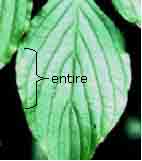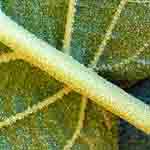|
Viburnum leaf
beetle home
Guide to identifying Viburnums
Common
names
Is
it a viburnum?
Which
viburnum?
Express key
ID
tutorial
Guide to viburnums by David Swaciak.
Leaf drawings by
Marcia Eames-Sheavly.
Logo
images by Paul Weston & Craig Cramer
|
9A1.
If the leaf margin (edge) is entire (smooth, no teeth) and the underside is
smooth, you do not have a viburnum.
|
 |
|
9A2.
If the leaf margin has teeth or if the margin is entire but
the underside is pubescent (velvety covering under magnification), you have a viburnum.
Go to Which viburnum is it? |
|

Click for larger image of pubescence on the underside of a leaf. |
Tip: See the ID tutorial for more about leaf pubescence.
If you chose 9A1 above, your plant is most likely a:
- Fringe tree (Chionanthus sp.)
More information and pictures from: Cornell | UConn
- Dogwood (Cornus sp.)
Search these databases for Cornus: Cornell | UConn
- Shrubby St. Johnswort (Hypericum prolificum)
More information and pictures from: Cornell | UConn
- Honeysuckle (Lonicera sp.)
Search these databases for Lonicera: Cornell | UConn
- Snowberry (Symphoricarpos albus sp.)
More information and pictures from: UConn
- Lilac (Syringa sp.)
Search these databases for Syringa: Cornell | UConn
Remember: You are not required to identify viburnums all the way to species before submitting your observations via our online forms. As long as you are confident that you have a viburnum, you can enter your data now. We hope that you will try to identify the species so that we can learn more about which ones are most resistant to this pest. To try to identify your viburnum to species, continue with Which viburnum is it?
© Copyright, Department of Horticulture, Cornell University.
Project coordinator: Lori Brewer, ljb7@cornell.edu
Website design: Craig Cramer cdc25@cornell.edu
Mention of trade names and commercial products is for educational
purposes; no discrimination is intended and no endorsement by Cornell
Cooperative Extension or Cornell University is implied. Pesticide
recommendations are for informational purposes only and manufacturers'
recommendations change. Read the manufacturers' instructions carefully
before use. Cornell Cooperative Extension and Cornell University assumes
no responsibility for the use of any pesticide or chemicals. Some
of the links provided are not maintained by Cornell Cooperative Extension
and Cornell University. Cornell Cooperative Extension and Cornell
University are not responsible for information on these websites.
They are included for information purposes only and no endorsement
by Cornell Cooperative Extension or Cornell University is implied.
Cornell Cooperative Extension provides equal program and employment
opportunities. |